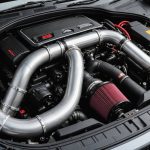A Step-by-Step Guide to Replacing Front Fork Seals on Your Kawasaki Ninja H2
Replacing the front fork seals on your Kawasaki Ninja H2 is a crucial maintenance task that can significantly impact the performance and safety of your bike. Here’s a comprehensive guide to help you through the process, ensuring you have all the information and tools you need.
Preparing for the Job
Before you start, it’s essential to gather all the necessary tools and parts. Here’s a detailed list of what you’ll need:
Also read : Essential Tips to Guarantee Optimal ABS Performance on Your Kawasaki ZX-10R
- New front fork seals: Make sure these are compatible with your Kawasaki Ninja H2 model. You can find OEM parts or aftermarket alternatives from reputable sources like Webike or HardRacing[3][4].
- Fork oil: The correct viscosity and type of fork oil is crucial for the performance of your forks.
- Fork seal driver: This tool helps in installing the new seals without damaging them.
- Socket set and wrenches: For disassembling the fork components.
- Clean rags and solvent: For cleaning the fork tubes and other components.
- Workstand or paddock stand: To lift the bike and give you better access to the front forks.
Disassembling the Front Forks
Disassembling the front forks is the first step in replacing the seals. Here’s how you can do it:
Removing the Front Wheel and Caliper
- Start by removing the front wheel. This will give you clear access to the fork.
- Use a wrench to loosen the caliper bolts and slide the caliper off the disc. Be careful not to damage the brake hose.
Taking Apart the Fork Tubes
- Use a socket to remove the fork cap and drain the fork oil.
- Remove the spring and any spacers or preload adjusters. Note the position and configuration of these components for reassembly.
- Slide the fork tube off the fork leg, taking care not to damage the seals or the fork tube.
Accessing the Seal Area
- Once the fork tube is removed, you’ll see the old seal. Use a seal puller or a flathead screwdriver to carefully remove the old seal.
Cleaning and Inspecting the Fork Components
Cleaning and inspecting the fork components is crucial to ensure the new seals function properly.
Also read : Step-by-Step Guide: How to Tighten Spokes on Your BMW F750GS for Enhanced Performance
Cleaning the Fork Tubes
- Use a clean rag and solvent to wipe down the fork tubes, removing any dirt or old seal residue.
- Inspect the tubes for any scratches or damage. If damaged, consider replacing the tubes.
Inspecting the Fork Legs
- Clean the fork legs and inspect them for any signs of wear or damage.
- Check the bushings and guides for any wear. If they are worn out, replace them to ensure smooth operation.
Installing the New Seals
Installing the new seals requires care to avoid damaging them.
Applying New Seal Lubricant
- Apply a small amount of fork oil or seal lubricant to the new seal.
- Make sure the seal is properly seated on the seal driver.
Installing the New Seal
- Use the seal driver to push the new seal into place. Ensure it is seated evenly and not twisted.
- Once the seal is in place, use a clean rag to wipe away any excess lubricant.
Reassembling the Front Forks
Reassembling the front forks is essentially the reverse of disassembling them, but here are some key points to consider:
Reinstalling the Spring and Preload Adjusters
- Slide the spring and any spacers or preload adjusters back into place. Ensure they are in the same configuration as before.
- Adjust the preload according to your preference and the manufacturer’s recommendations.
Refilling the Fork Oil
- Refill the fork with the correct amount and type of fork oil. Refer to your Kawasaki Ninja H2 manual for specifications.
- Reinstall the fork cap and tighten it securely.
Reinstalling the Front Wheel and Caliper
- Slide the caliper back over the disc and tighten the caliper bolts.
- Reinstall the front wheel and tighten the nuts securely.
Adjusting and Testing
After reassembling the front forks, it’s crucial to adjust and test them to ensure everything is working correctly.
Adjusting the Preload and Rebound
- Adjust the preload and rebound settings according to your riding style and preferences. The Kawasaki Ninja H2 has adjustable preload and rebound settings to fine-tune the fork’s performance[3].
Testing the Forks
- Take the bike for a test ride to ensure the forks are functioning smoothly and there are no leaks.
- Check for any signs of leakage around the seals and adjust the fork settings as necessary.
Practical Insights and Actionable Advice
Here are some practical insights and actionable advice to keep in mind:
Regular Maintenance
- Regularly check and maintain your front forks to prevent wear and tear. This includes checking the fork oil level and condition, and adjusting the preload and rebound settings as needed.
Using the Right Tools
- Always use the right tools for the job to avoid damaging the components. A fork seal driver, for example, is essential for installing new seals without damaging them.
Consulting the Manual
- Always consult your Kawasaki Ninja H2 manual for specific instructions and recommendations. The manual will provide detailed information on the correct procedures and specifications.
Table: Comparison of OEM and Aftermarket Fork Seals
| Feature | OEM Fork Seals | Aftermarket Fork Seals |
|---|---|---|
| Quality | High-quality materials and manufacturing | Can vary depending on the manufacturer |
| Compatibility | Guaranteed compatibility with Kawasaki Ninja H2 | Ensure compatibility before purchase |
| Price | Generally more expensive | Often cheaper than OEM parts |
| Warranty | Usually comes with a warranty | Warranty varies by manufacturer |
| Performance | Optimized for the specific bike model | Can offer different performance characteristics |
Quotes and Anecdotes
From a Kawasaki Ninja H2 Owner
- “Replacing the front fork seals on my Kawasaki Ninja H2 was a game-changer. The bike handles so much better now, and I can feel the difference in stability and speed.” – John D., Kawasaki Ninja H2 owner.
From a Mechanic
- “When replacing front fork seals, it’s crucial to use the right tools and follow the correct procedures. This ensures the seals last longer and the forks perform optimally.” – Mark S., motorcycle mechanic.
Replacing the front fork seals on your Kawasaki Ninja H2 is a manageable task if you have the right tools, parts, and knowledge. By following this step-by-step guide, you can ensure your bike’s front forks are in top condition, enhancing both performance and safety.
Remember, regular maintenance is key to extending the life of your bike’s components. Always consult your manual, use the right tools, and take your time to ensure everything is done correctly.
Additional Tips
- Keep a Maintenance Log: Keep track of when you last replaced the fork seals and other maintenance tasks to ensure you stay on top of your bike’s needs.
- Read Reviews and Forums: Read reviews and forums to get insights from other riders who have performed the same task. This can provide valuable tips and tricks.
- Consider Professional Help: If you are not comfortable with the process, consider taking your bike to a professional mechanic. They have the experience and tools to do the job correctly.
By following these tips and the detailed guide above, you’ll be able to replace your front fork seals with confidence, ensuring your Kawasaki Ninja H2 continues to perform at its best.











